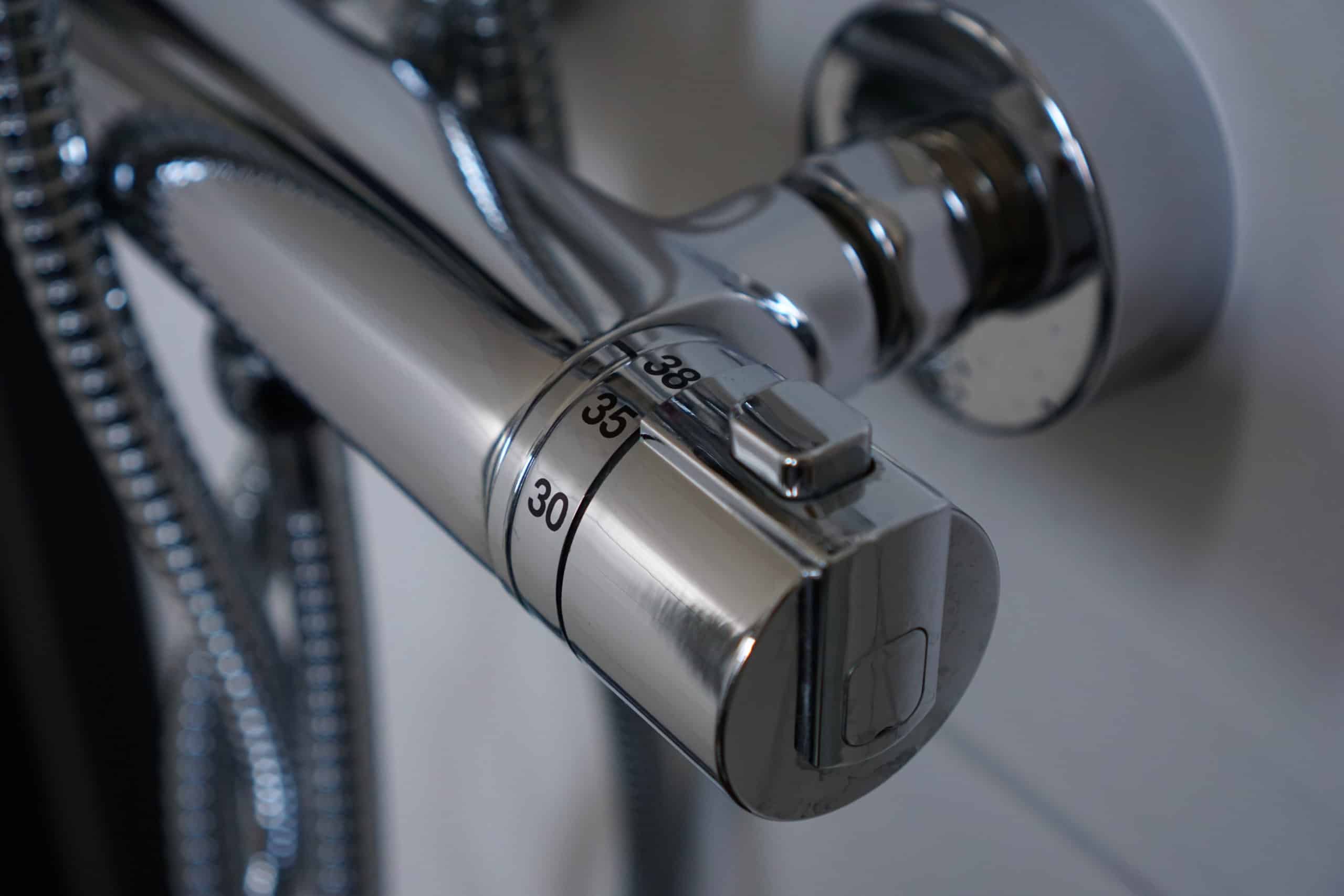Thermostatic showers: what are they, and how do they work?

Stepping into the shower should be a moment of comfort and relaxation, not a risky adventure with scalding hot or freezing cold surprises.
That’s where thermostatic showers come in.
These clever devices maintain your preferred water temperature regardless of what else is happening in your home’s water system.
Whether you’re concerned about safety for yourself or loved ones with mobility challenges (or simply tired of temperature fluctuations ruining your showering experience), a thermostatic shower offers a practical solution that combines safety, comfort, and convenience.
Get a FREE Brochure
Fill out the form in seconds and discover our full range of assisted bathing showers and baths.

- What is a Thermostatic Shower?
- How does a thermostatic shower work?
- How to install a thermostatic shower
- How to replace a thermostatic shower valve?
- What are the benefits of a thermostatic shower?
- Choosing a mixer shower or thermostatic shower
- How can Premier Care in Bathing help?
What is a Thermostatic Shower?
A thermostatic shower is a specialised shower system with a built-in thermostat that automatically regulates water temperature.
Unlike standard shower mixers, which simply blend hot and cold water manually, thermostatic showers contain sophisticated internal mechanisms that respond instantly to changes in your water supply.
The heart of the system is the thermostatic valve, which constantly monitors and adjusts the mix of hot and cold water to maintain your chosen water temperature. This means if someone flushes the toilet, switches on the washing machine, or starts running the dishwasher while you’re showering, you won’t experience those shocking temperature spikes or drops that can be especially troublesome for older adults and people with sensitive skin.
The best thing about thermostatic showers is how they provide consistent comfort without constant readjustment.
All you have to do is set your preferred temperature, and the thermostatic shower will do the rest.
How does a thermostatic shower work?
Inside every thermostatic shower, you’ll find a specialised valve containing a thermostatic element. This is usually a wax or metal component that expands or contracts in response to temperature changes.
Here’s the clever part. When this element detects a temperature change in your home’s water supply, it automatically adjusts the mix of hot and cold water flowing through.
If your hot water supply suddenly drops in pressure (when someone turns on a tap in another room), the valve immediately reduces the cold water flow to compensate, keeping your shower at the perfect temperature.
Most thermostatic showers have the following features:
- Temperature control handle. This allows you to set your desired temperature.
- Flow control handle. This is a separate control for water pressure, which allows you to adjust the water pressure without affecting the temperature.
- Safety stop button. This prevents the temperature from being accidentally set too high. Most thermostatic showers are limited to 38 °C unless deliberately overridden.
- Anti-scald mechanism. This automatically cuts off the hot water if the cold supply fails, preventing the risk of burns.
For older adults and people with mobility issues, this technology offers valuable peace of mind, eliminating the need to react quickly to sudden changes in temperature and reducing the risk of slips or falls while adjusting shower controls.
How to install a thermostatic shower
Installing a thermostatic shower is a complex task, so you may wish to employ a professional.
If you’re wondering how to fit a thermostatic shower in a walk-in shower setup or accessible bathroom, here’s a straightforward guide to what’s involved:
- Before you start, check water pressure compatibility. You’ll need to make sure your home’s water system (both hot and cold) has sufficient pressure for a thermostatic valve. Most modern units require a minimum of 0.1 bar.
- Consider positioning carefully. For walk-in showers, controls should be easily accessible without reaching through water - ideally on the entry side.
- Plan for accessibility. For wheelchair users or people with limited mobility, controls should be installed at a comfortable height (typically 1000-1100 mm from the floor)
- When you’re ready to start your installation, switch off the water supply using the stopcock.
- Remove the existing shower fixtures, taking care to remove all components.
- Prepare the wall. For concealed thermostatic showers, you’ll need to create a recess in the wall.
- Mount the valve body. Secure the thermostatic valve according to manufacturer instructions. Make sure it’s level!
- Connect the hot and cold water pipes to the correct inlets (these are usually marked red for hot and blue for cold).
- Connect the shower head and/or handset, ensuring flexible hoses are long enough for seated use if required.
- Attach the temperature and flow controls and check that they move smoothly.
- Turn the water back on, check for leaks, and make sure the temperature regulation is working properly.
- Consider installing grab bars, a fold-down shower seat, and a handheld shower attachment on a sliding rail for maximum accessibility and comfort.
How to replace a thermostatic shower valve
Over time, even the best thermostatic shower valves may need to be replaced.
Learning how to replace a thermostatic shower valve can save you money and extend the life of your shower system.
If your valve needs replacing, you might notice:
- Temperature fluctuations, despite the thermostatic features
- Leaking from the control handles
- Difficulty turning the controls
- Strange noises when adjusting the temperature.
To replace the valve, you will need significant hand strength and dexterity. You can either employ a professional or do it yourself.
If you are able to replace the valve yourself, here are the steps you will need to follow:
- Switch off the hot and cold water supplies and any electrical connections.
- Remove the control handles. These are often secured with small screws or push-fit mechanisms.
- Remove any trim plates which may be in place to hide fixing screws.
- Extract the old valve. You may need to unscrew retaining nuts or clips.
- Clean the mounting area, removing dust, dirt, and limescale buildup.
- Install the new valve, ensuring it's oriented correctly with the hot and cold connections.
- Replace the trim plates and handles, ensuring the temperature limiters are correctly positioned.
- Calibrate the valve according to the manufacturer's instructions.
What are the benefits of a thermostatic shower?
- The anti-scald feature cuts hot water flow immediately if the cold supply fails.
- Eliminates sudden hot or cold surges that might cause startling or slipping.
- Pre-set temperature limits. Maximum temperature can be capped to prevent accidental overheating.
- Personalised showering experience. You can set the exact temperature that suits your preference.
- No waiting. Modern thermostatic showers provide your desired water temperature almost instantly.
- Separate flow control. You can adjust the water pressure without affecting the temperature.
- Memory settings. Many models remember your preferred temperature between uses.
- Reduced water waste. There’s no need to run the shower and wait for the right temperature. This could also lead to reduced energy bills.
- Easy for everyone. Thermostatic showers are simple to use, even for people with arthritis or limited dexterity.
Mixer Shower vs Thermostatic Shower
Mixer showers combine hot and cold water manually through a single control handle with no automatic regulation. They’re cheaper, simpler mechanically, and work with lower water pressure, but water temperature fluctuates when water is used elsewhere, requiring manual adjustments and posing scalding risks.
Thermostatic showers automatically maintain your chosen temperature regardless of other water usage. They provide consistent temperature, built-in safety features against scalding, and separate temperature and flow controls. However, they cost more initially, may need minimum water pressure, and have more complex components.
For older adults and people with mobility issues, the safety benefits of thermostatic showers typically justify the higher initial outlay.
How can Premier Care in Bathing help?
Whether you’re planning a walk-in bath installation or installing a brand-new wet room, a thermostatic shower offers the ultimate blend of practical functionality and luxurious comfort that makes every shower a pleasant experience.
At Premier Care in Bathing, we’re experts in designing stylish and modern accessible bathrooms, designed for elderly people or people with limited mobility.
All of our specially designed showers feature thermostatic control safety as standard. And with 30 years of experience in transforming our customer's bathrooms, you’re in safe hands.
We’ll take care of every step of updating your bathroom, from a free home survey where our experts fully assess your current situation and preferences to fitting your dream bathroom to your exact specifications.
Throughout the process, you’ll have a dedicated advisor to oversee the project and answer any questions you might have.
Once our team has finished, they will clear everything up so that all that’s left for you to do is relax and enjoy your brand-new, modified bathroom.
To find out more, call our friendly team today.

